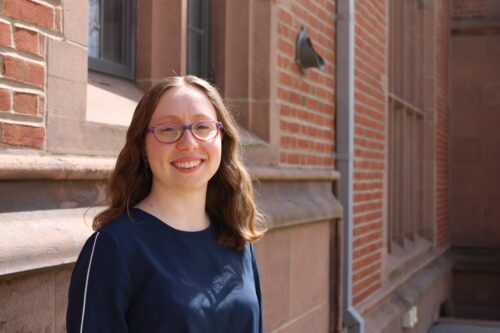Photography by Hannah Han.
This June, graduates from Yale’s Class of 2013 will flock back to campus for their ten-year reunion. For Amymarie Bartholomew (YC ’13), the trip will be as simple as a walk down Science Hill from her new lab at Kline Chemistry Laboratory. Appointed an assistant professor in January of this year, Bartholomew now works in the chemistry department alongside many of the faculty members she had as teachers and mentors during her time as an undergraduate.
Back and better than ever, Bartholomew is a doctorate-wielding chemist whose work focuses on synthesizing stimuli-responsive inorganic materials. The graduate-level course she teaches, “Molecular Materials,” reflects the aims of her research: to produce materials that change their physical, magnetic, and electrical properties in response to interactions at the molecular level. For instance, the absorption of light might change the way bonds form, or an increase in temperature might alter the way electrons behave in a magnetic field.
Bartholomew thinks of her work as a search for new ways to apply these tiny molecular changes to the creation of useful materials. “I’ve always had a lot of ideas for things to synthesize and things to try, and I think in chemistry—as well as in other fields—it’s really about just trying things,” Bartholomew said. “Being able to see which of my ideas hold promise and which of them are able to move forward—I think that’s really exciting.”
One project the lab group is working on seeks to use the molecule azobenzene to produce electricity from sunlight. For a long time, scientists have known that azobenzene can switch between two shapes: one that bends back on itself and one that is long and straight. When high-energy ultraviolet light strikes azobenzene crystals, they tend to flex and deform as their many constituent molecules switch between the two shapes. Bartholomew’s research is taking this behavior of azobenzene to new heights. By creating larger molecules that contain multiple azobenzene components bonded at special angles, Bartholomew and her collaborators have produced a material that rotates around a central axis when exposed to visible light. Under a microscope, crystals of this material appear to continuously roll like long axles, performing the kind of mechanical work that can generate electricity. Bartholomew hopes that this single-step conversion from solar energy to mechanical work will provide a starting point for more efficient solar power.
Bartholomew also focuses on the kinds of stimuli-responsive changes that could pave the way for new nanoscale electronics. Like the azobenzene complexes, most of Bartholomew’s materials are crystalline in structure. Not only does the ordered pattern of crystals make for useful physical properties, but it also provides chemists with an insight into how and why stimuli responses occur. “If you ever need to find me, I’m probably trying out crystals on the diffractometer in the crystal lab,” Bartholomew said. “I love being able to make something, crystallize it, and then use those crystals to determine the three-dimensional structure of what I’ve made.”
The research that Bartholomew has carried out in her first months as a professor has largely taken place thanks to generous colleagues who have lent their research spaces to her. After all, it takes time to acquire all the equipment necessary to run a cutting-edge chemistry lab. Bartholomew’s own space is just a short walk from the lab of chemistry professor Nilay Hazari, where Bartholomew conducted research as an undergraduate. Bartholomew explained that Hazari acts as a model for her now that she has the responsibility of mentoring. Bartholomew also credited Professor Kurt Zilm, the instructor of her undergraduate physical chemistry class, for showing her how to teach chemistry. “I think pedagogically I definitely took a lot from that class—hopefully. You’ll have to ask the graduate students in my class now if that’s the case, but that’s the aim anyway,” Bartholomew said.
Now with the classroom and the lab under her control, Bartholomew is putting her own creativity to the test. Fortunately, Bartholomew has an endless stream of fresh ideas in her niche of synthetic chemistry. “I sit at home and think of new things we should try to make, and I have to sketch them out at like ten p.m. and send myself a weird email with two sentences of an idea,” Bartholomew said. To handle the strange world of molecular materials, there may be no better approach.

